Home to Disneyland, Hollywood, and the Golden Gate Bridge, California is a massive state that spans nearly the entire west coast of the United States, each spot containing some unique feature, both man-made and natural! With all of that land comes different climates, from moist and chilly temperate forests in the north to dry and sunny deserts in the south. As you can guess, that makes California the home to many different plants, native and introduced, that all interact with creatures big and small to create the state’s unique beauty!
In this article, we will discuss one of California’s most important resources, native plants, what they are, different types you can find throughout the state, and how you can help their populations flourish. Plus, we will talk a bit about one of native plants’ worst enemies, invasive plants, and list a few you may find in your own garden.
The Importance of Native Plants
As a home gardener or aspiring naturalist, you may have heard a thing or two about native plants. You may know that they’re important and that you should use them in your landscape, but that’s possibly where the information ends. So, we would like to offer you a bit more of the story!
Native plants are plant species that occur naturally in a given area. They do not abide by our political borders, growing along mountain ranges and waterways that cross states, through meadows and forests of different continents!
But, above all, native plants provide many benefits to the landscapes in which they belong. Since they belong there, they provide food and shelter for animals who are also native to the area. This helps increase biodiversity, or the diversity of species, which in turn helps maintain and nourish an ecosystem. Native plants also aid in protection against natural disasters, stabilizing the earth, blocking wind, and soaking up flood waters to name a few.
Native Plants of California
Of course, there are many native plants that call California home! With the state’s wide range of climates and landforms, California’s native plants are extremely varied. There are many plants that are also native to California’s neighbors, like Oregon and Arizona. So here, we have listed out just a few of these natives you may find and want to grow in your California garden!
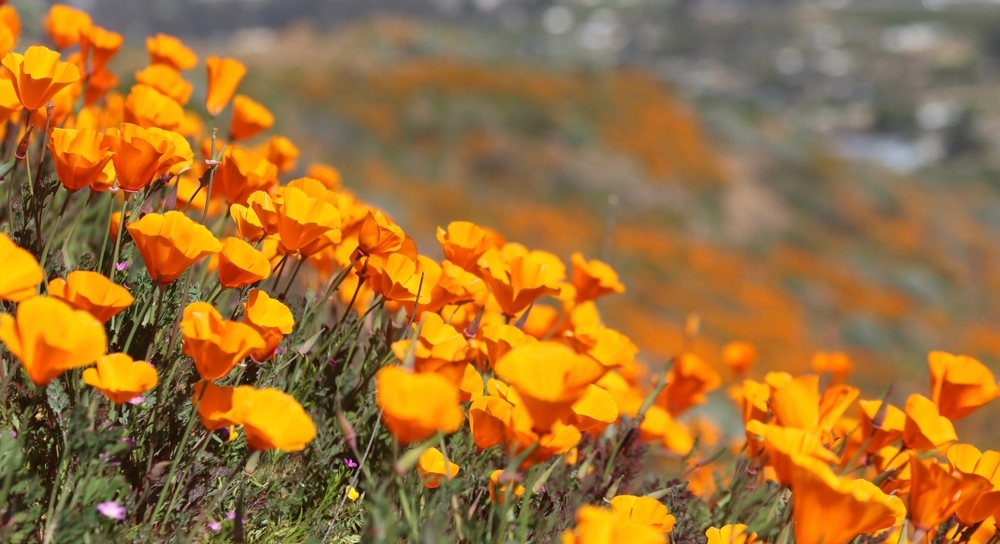
Perennials
California Poppy (Eschscholzia California)
California’s state flower, this bright orange wildflower is a staple of California meadows. It requires warm, sunny days, and actually closes its petals during weather that’s too cold. But don’t worry; as long as the warmth returns, the California poppy will open its soft, golden petals once again! This beautiful native is great for any California perennial garden, seeding in each season to ensure next year’s growth.
Western Wild Ginger (Asarum caudatum)
Found in moist and cool conditions, western wild ginger is a native resident of the shady forests of Northern California. In a native garden, be sure not to give this plant any direct sunlight, but rather, use it as the herbaceous level of your garden’s understory, or possibly just a shady corner. Western wild ginger, like most Asarum species, has heart shaped leaves and very unique, brownish-red flowers. When pressure is applied, the plant will give off a calming aroma of ginger, making it a great groundcover for shady native forest gardens!
California Polypody Fern (Polypodium californicum)
Found all along the California coast, the California polypody fern is the perfect native fern for shady, well-drained areas. Its small, green fronds unfurl as it grows on coastal bluffs, canyons, river banks, and shady cliffs, spreading through the landscape using hairy rhizomes. And just like all ferns, the California polypody reproduces through spores located on the underside of its leaves, a truly amazing and ancient plant, a native resident since the time of the dinosaurs!
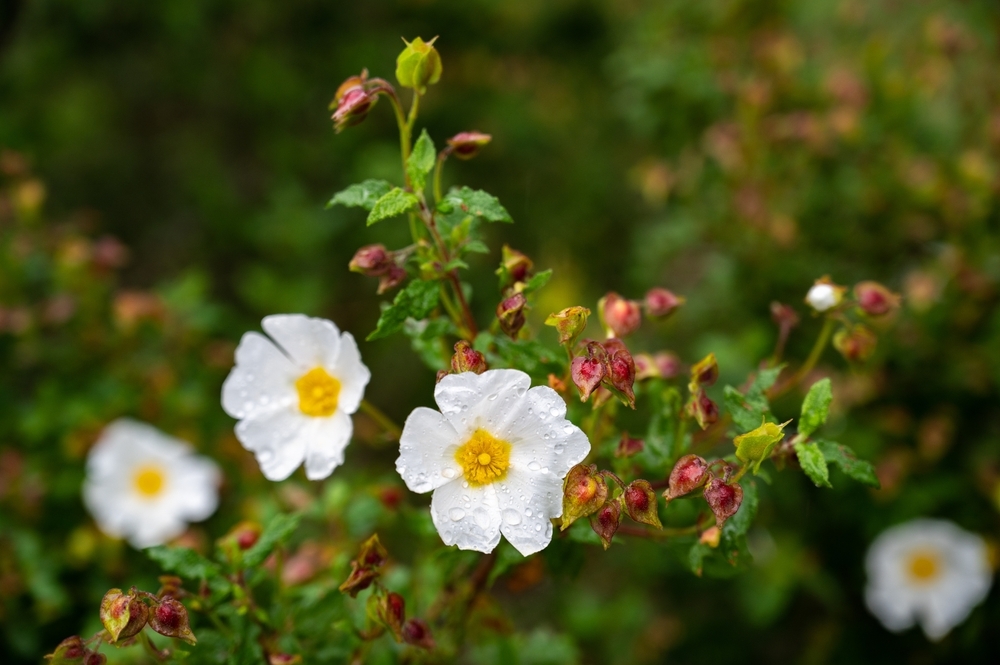
Shrubs
California Sagebrush (Artemisia californica)
California sagebrush is a great scented shrub that can be found in many dry, coastal areas of Central and Southern California. Its soft, blue-green leaves release a strong fragrance when touched, making it a nice choice for your native sensory garden. It requires little to no water and is the native plant of choice for the threatened bird, the California gnatcatcher, making this plant a true jack of all trades in your landscape!
Bush Anemone (Carpenteria californica)
A rare evergreen shrub, bush anemone is endemic to California in just a few sites in Fresno and Madera Counties. Though it grows extremely well in fire-ravaged areas, sending up new shoots from below the burned landscape, bush anemone is not great at spreading via seed. If uninterrupted by wildfires, it will grow up to 10 feet tall and wide, producing fragrant white or yellow flowers in spring and summer. It’s a great choice for a native pollinator garden or just any well-drained, sunny spot in your landscape!
Coffeeberry (Frangula californica)
Named for its berries’ striking resemblance to those of the coffee plant, coffeeberry is a great evergreen, mounding shrub for many California native gardens. Found throughout the entire state, coffeeberry is dense, its leaves thick and its berries ripening to create the perfect snack for many species of birds. In fact, this native shrub is a good choice for many other reasons, as well! It can be used as a land stabilizer and even a fire barrier.
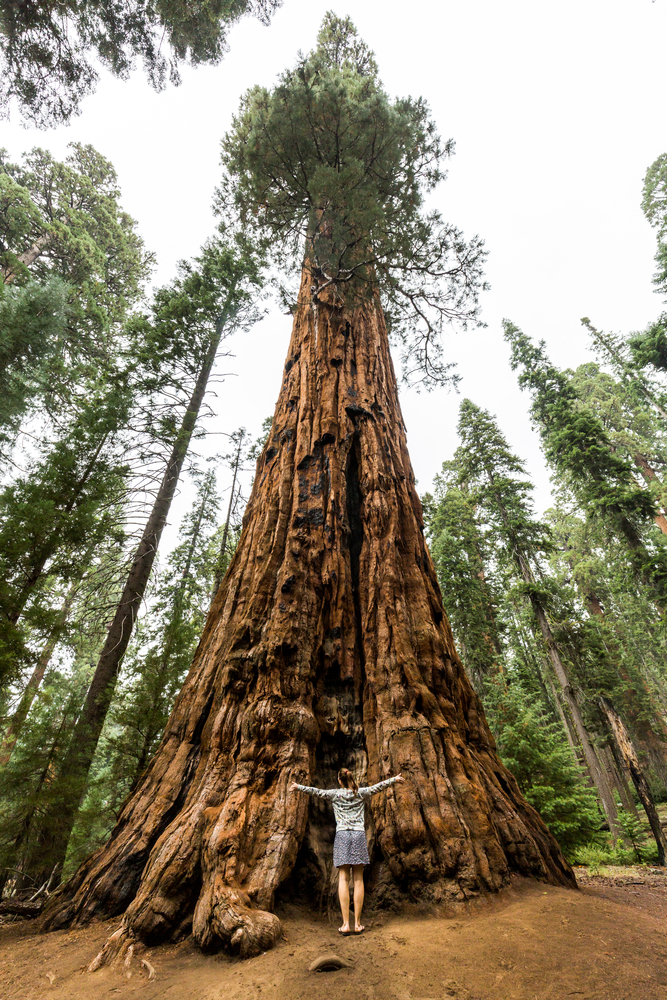
Trees
Coast Redwood (Sequoia sempervirens)
One of California’s state trees, the coast redwood is a gorgeous, gigantic tree that dates all the way back to the time of the dinosaurs. It is actually the tallest tree in the world, growing two to ten feet each year until they reach a whopping 400 feet tall! That’s twice as tall as San Francisco’s Coit Tower! Though this is a truly amazing tree, it’s certainly not a native tree for any California garden. Coast redwoods need a good deal of moisture and fog, making it’s perfect habitat no further than 50 miles from the Pacific Ocean. Not to mention, they require a great deal of space. So, if you would like to help these native giants, you may want to simply visit them at one of California’s state parks!
Giant Sequoia (Sequoiadendron giganteum)
The other state tree, the giant sequoia is a related species to the coast redwood. It does not grow as tall as its relative, but the giant sequoia is actually the world’s largest tree by volume, plus, they can live up to 1,000 years longer to be an amazing 3,000 years old! Giant sequoias are quite interesting in their reproduction methods, as well, requiring fire to germinate their seeds. This is a fascinating adaptation, and a very useful one to a state known for its unfortunate number of wildfires.
Island Oak (Quercus tomentella)
A very rare species found only on California’s islands in the Pacific ocean, the island oak tree used to be found all over the mainland, according to fossil evidence. It grows fast and relatively low as compared to the other two Californian trees, clocking in at a measly 60 feet tall. The island oak’s evergreen leaves are small and fuzzy, hence its Latin species name tomentella meaning hairy. In spring, it displays small white and yellow flowers that cascade down past its leaves. Once pollinated by insects like moths and butterflies, the island oak produces its acorns, which won’t mature for two years after they form.
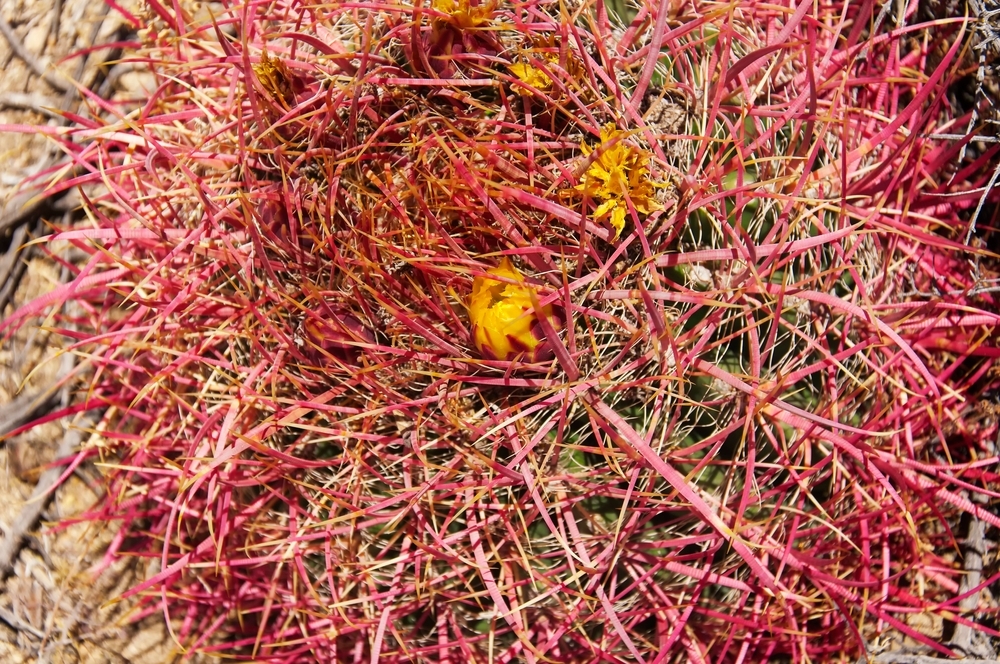
Desert Plants
California Barrel Cactus (Ferocactus cylindraceus)
Also known as Miner’s Compass due to its protective orientation towards the sun at noon, the California barrel cactus is a very pretty native cactus! When it is young, its long curved spine (which are actually modified leaves) are bright red, standing out in its dry, barren landscape and offering stunning contrast with its bright yellow flowers! As the California barrel cactus ages, those spines become off-white in color, and it can actually grow to be ten feet tall! It’s a great choice for any dry, hot, low-maintenance native California garden!
Desert Agave (Agave deserti)
Sending up flower stalks that can reach up to twenty feet tall, desert agave is a beautiful succulent desert native! Its fleshy, bluish-green leaves are lined with sharp spines, great for self-preservation. Desert agave is a bit of a slow grower, though, reaching reproduction maturity after up to 40 years! Once it is mature, though, this native sends up a flower stalk that is ready for pollination in days, opening up to reveal bright yellow blooms! Traditionally, Native Americans were known to eat the flowers and other parts of desert agave, a great snack in an otherwise harsh landscape.
Banana Yucca (Yucca baccata)
Banana yucca is another great desert plant for your native California garden! Like the others, it needs very low moisture, dry sandy soil, and a great deal of sun. Named for its banana-shaped fruit, banana yucca is a close companion and relative to the famous Joshua Tree. It has thin but sharp green leaves, so be careful if you touch them as they could certainly cut your skin. Like many desert plants, banana yucca is pollinated by nocturnal moths, making it a great draw for unique insects!
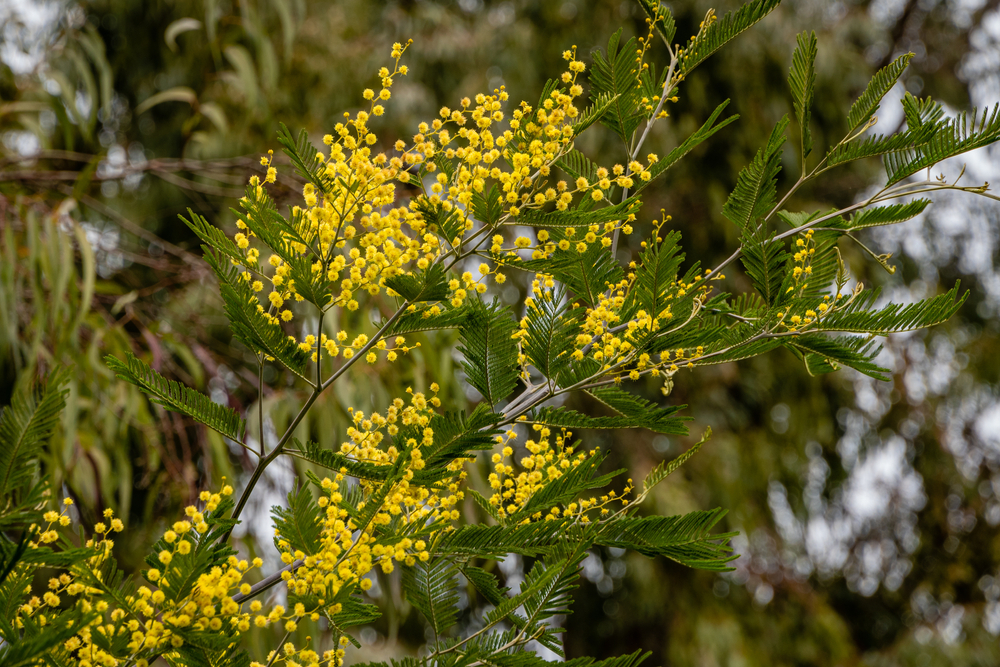
California’s Invasive Plants
Silver Wattle (Acacia dealbata)
Native to Australia, silver wattle is a tree that grows quickly and spreads easily. Using rhizomes, silver wattle sends out new growth over a wide area, making it difficult to eradicate. Once pollinated, its bright yellow flowers give way to seeds, allowing this invasive to spread even further by wind, water, and seed spreading creatures. Finally, silver wattle can even impact the soil’s chemistry, fixing nitrogen and making it difficult for native plants to grow there.
Scotch Broom (Cytisus scoparius)
As the name suggests, Scotch broom is native to Europe, but it can easily take hold in dry soils of California. Found along highways, in meadows, and in forests attempting to regenerate, Scotch brooms’s yellow flowers may be appealing, but beware: it not only crowds out native plants, but its dry, thick stems are surely hazardous fire-catchers. Not to mention, this invasive plant also contains toxic compounds that could poison animals if ingested in large enough amounts.
Sea Fig (Carpobrotus chilensis)
Native to southern Africa, the sea fig is actually a pretty succulent plant. When it blooms, soft purple flowers emanate from between its thick leaves. In time, the flowers give way to fruit that resembles a fig, hence its name. The sea figs can be found all over California, from grasslands and prairies to mountains and beaches, adding organic material to the soil as it dies and decays. In many areas, this process would be beneficial to the soil, but in California, the addition of this organic material changes the natural soil content. This allows other non-native plants to invade, as well, and of course, paves the way for more sea fig plants to grow.
Alligator Weed (Alternanthera philoxeroides)
A noxious water weed, alligator weed easily spreads on land and water. Interestingly, it’s believed that this invasive, which is native to South America, was introduced through the release of ballast water, or water held in ships to add weight when cargo is limited. Today, alligator weed is a nuisance for kayakers, swimmers, and more, quickly forming mats that lay atop the water. Unfortunately, its negative ecological impacts don’t end with water sports. Alligator weed is also known to clog drainage canals and irrigation lines, restrict oxygen levels and sunlight reach in the water, and out-compete native plants and animals.
Tree of Heaven (Ailanthus altissima)
Similar in appearance to its native counterpart Smooth Sumac, tree of heaven is an invasive tree from China. Once this tree becomes established, it is very difficult to remove it without using herbicides, so we would suggest removing its seedlings and saplings as soon as you see them. Keep in mind, the leaves of the invasive tree of heaven have an odor that most do not find appealing; this could help you identify it.
5 Things You Can Do to Help California’s Native Plants
California native plants and trees face threats from climate change, habitat loss, and invasive species. Conservation efforts are underway to protect them. Initiatives include reforestation projects, the establishment of protected areas, and the promotion of sustainable harvesting practices.
But, as a home gardener, you may wonder how you can get involved, how you can help protect California’s native plant population. Well, don’t you worry, because we’ve compiled a list of 5 things you can do to help!
- Bye bye, Invasive Plants!
As long as you have the right equipment – gloves, soil knives, and pruners – feel free to help the environment by getting rid of invasive plants like the ones listed above!
- Hello, Native Plants!
Once you remove those pesky invasive plants from your landscape, why not replace them with helpful natives? Visit your local garden center for fully grown specimens or simply start off with seeds, like California Poppy, Bush Anemone, or even Giant Sequoia!
- Welcome Home, Pollinators!
One surefire way to help native plants is to help their pollinators! Refrain from using harmful pesticides in the garden, as they will kill pests as well as pollinators. Plus, you could even purchase things like bee boxes or birdhouses to make pollinators and seed spreaders feel welcome in your space!
- Natural Fertilizers!
Sometimes, you may want to give your native plants some extra love with fertilizers. However, there’s really no need to drench the earth with harsh chemicals to do so. Instead, try using natural fertilizers like liquid seaweed!
- Get Involved!
Chances are, if you’re interested in helping out the environment in your neighborhood, others are, as well. So, check out your local parks departments, botanic gardens, and arboretums to see if they’re hosting any volunteer activities. You may find outings to remove invasives from parks, install natives in gardens, or care for city trees! But, of course, sometimes the most important place to start is your own backyard!
